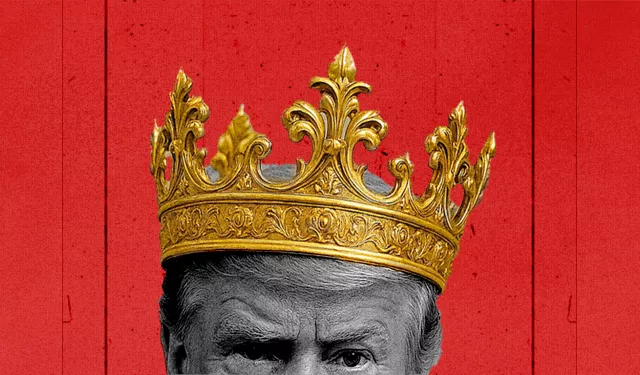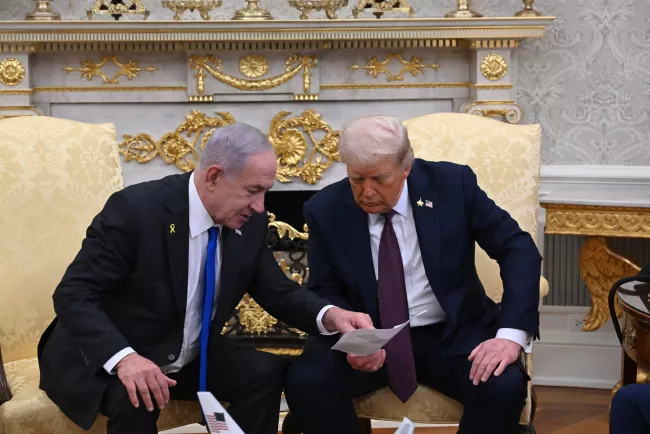
Because Trump’s plan for Gaza is the only available option
The rapid embrace of US President Donald Trump’s Gaza peace initiative, announced Monday, underscores the limited choices available to parties active in the conflict. While many states welcomed the plan, two diplomats told Al Manassa that such gestures should not be read as full endorsement. Rather, they represent attempts to encourage Trump to assume a more active role in halting the ongoing war.
Trump revealed the plan during his meeting with Israeli PM Benjamin Netanyahu at the White House. Several of the proposal’s 20 points reflect a regional and international consensus on an immediate ceasefire, no forced displacement of Gaza’s population, delivery of adequate humanitarian aid, the reconstruction of essential infrastructure, hospitals, and bakeries, and the entry of equipment to clear rubble and reopen roads.
At a joint press conference, Trump emphasized that the plan enjoyed backing from Arab and Islamic states, along with European participation in the negotiations. He predicted a “positive response” from Hamas.
Arab and global states positive
The proposal drew varied reactions. It received immediate support from Western, Arab, and Islamic states, as well as international organizations. Netanyahu endorsed it enthusiastically. By contrast, resistance movements, including Islamic Jihad, condemned it as “a recipe for igniting the region.”
In a joint statement, the foreign ministers of Egypt, Jordan, the UAE, Indonesia, Pakistan, Turkey, Saudi Arabia, and Qatar welcomed Trump’s framework, highlighting its promises to end the war, reconstruct Gaza, prevent forced displacement, and block the annexation of the West Bank. They praised Trump’s “leadership and sincere efforts” and affirmed their readiness to cooperate constructively with Washington and other stakeholders to finalize and implement the plan.
The victor dictating to the defeated
Speaking to Al Manassa, Maj. Gen. Mohamed Abdel Wahed, an expert in regional security, argued that the plan amounted to “dictates from a victor to the vanquished” rather than a genuine peace plan. He noted that the plan sidesteps Palestinian rights and is “vague and riddled with loopholes.” He suggested that threats of significant escalation may have preceded its unveiling, explaining the regional readiness to accept it.
Former Assistant Foreign Minister Rakha Ahmed Hassan described the reception as “merely a preliminary welcome to avoid rejection from the start.” He anticipated that future negotiations would be necessary to address problematic provisions.
Hassan stressed that the main objective behind the cautious welcome was to stop what he called the “genocidal campaign and systematic, brutal destruction in Gaza, and out of mercy for the people of Palestine, who are being displaced from one place completely unfit for human habitation to another.”
Ayman Al-Raqab, professor of political science at Al-Quds University, viewed the initiative as undermining global momentum towards Palestinian statehood. He expressed concern to Al Manassa about provisions that restructure Gaza’s governance and security apparatus, pointing to Article 9, which proposes a “Board of Peace.” This international transitional body, chaired by Trump and including former British Prime Minister Tony Blair, would supervise a non-political, technocratic Palestinian committee tasked with providing municipal services.
Former Assistant Foreign Minister Hassan warned that Trump’s leadership of such a council would allow him to shape Gaza according to his own vision, irrespective of Palestinians’ needs, noting that the greater danger lies in this takeover. He emphasized the absence of provisions linking Gaza’s reconstruction with development in the West Bank.
Al-Raqab concurred, describing the framework as a “submission plan” that fulfills Netanyahu’s five stated objectives, which include the disarmament of Hamas, demilitarization of Gaza, Israeli security control, and the installation of a proxy authority not affiliated with the Palestinian Authority/PA or Hamas.
Several experts also pointed to the irony of former UK PM Blair’s involvement. Former Assistant Foreign Minister Gamal Bayoumi dismissed him as “America’s lapdog,” recalling his role in supporting the US-led invasion of Iraq in 2003. Hassan noted Blair’s repeated refusal to apologize for Britain’s participation in that war.
Structural separation of Gaza
Netanyahu stressed that Israel would “retain responsibility for security” in Gaza under the plan. Article 16 specifies that Israeli forces will “progressively hand over the Gaza territory it occupies ... until they are withdrawn completely from Gaza, save for a security perimeter presence that will remain until Gaza is properly secure from any resurgent terror threat.”
Al-Raqab interpreted this as a clear plan to completely separate Gaza from the West Bank. He predicted that Israel and the US might create proxy militias similar to past local forces, such as the group led by Yasser Abu Shabab in Rafah.
Staged withdrawals would also leave Israel deeply entrenched in Khan Younis and Rafah, thereby preserving substantial security control. Although the plan states that no new settlements will be built, Al-Raqab argued that it effectively reduces Gaza’s territory by about one-third, confining its population to a smaller, denser area.
Abdel Wahed warned that such measures would render Gaza increasingly uninhabitable, encouraging natural population decline through emigration. He considered the language of “those who wish to remain” versus “those who do not” a deliberate attempt to engineer Gaza as a hostile living environment to force displacement.
Notably, the plan does not clearly stipulate the establishment of an independent Palestinian state on the June 4, 1967 borders. The penultimate article only vaguely suggests that as reconstruction progresses and the Palestinian Authority implements reforms, conditions may “finally be in place for a credible pathway to Palestinian self-determination and statehood, which we recognize as the aspiration of the Palestinian people.”
The proposed international force
Article 15 outlines the creation of a temporary International Stabilization Force/ISF, to be deployed in Gaza in coordination with Arab and international partners. The ISF would train local police and consult with Egypt and Jordan. It is envisioned as Gaza’s long-term internal security solution.
Abdel Wahed cautioned that the provision seeks to internationalize the issue without clarifying the force’s mandate or terms of reference. He raised concerns about whether it would function as a monitoring, peacekeeping, or enforcement force, warning that assigning such responsibilities to Arab troops would risk turning them into auxiliaries for Israeli objectives and shifting the burden of accountability for wartime abuses onto the Arab world.
In conclusion, Trump’s so-called peace plan wasn’t designed as a project to end the war or achieve a negotiated agreement. Instead, it was put forth as the sole option available to all: not a draft for discussion, but a blueprint in which the US President dictated the role of every party and specified the actors who would be completely excluded from the map he is drawing.



